There are a lot of different materials that makers in the spinning things industry can use. However, there are a couple of factors which mean that most stick to a list of commonly used materials. They can range from elemental metals like copper and aluminium, to complex laminates like Damascus steel and super conductor.
For the most part exotic materials are used for purely aesthetic reasons. Materials such as super conductor for example can actually cause problems with spinning, and so are purely aesthetic. They can however give a totally unique look to an item which might otherwise not get a second glance. They are understandably much more expensive than basic metals though.
What is my Spinner made of?
Here is a brief guide to the commonly used metals and materials found in fidget spinners, and spinning tops.
| Name | Abbreviation | Picture | Description |
|---|---|---|---|
| Stainless Steel | SS | 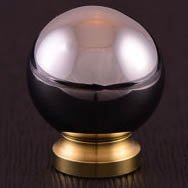 | Stainless Steel is a steel alloy which is a combination of steel and Chromium. It is resistant to rust and wear. When flamed, it turns to a dark grey, with some blues and yellows. |
| Copper | Cu |  | Copper is its own element. It is a metal known for being soft, and ductile. It is very susceptible to rust (patina) and dents/marks. When flamed it goes a deep red. |
| Bronze | Br | 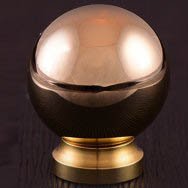 | Bronze is an alloy of copper, tin, and generally one other metal like aluminium. It is stronger and more durable than Brass which has a very similar gold like colour. |
| Brass | BR | 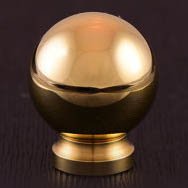 | Brass is an alloy of copper and zinc. It has a very similar gold colour to bronze, but is much more ductile and malleable. This means it creates less wear on machinery and is very good for prototyping. |
| Aluminium (Aluminum) | - | 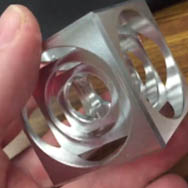 | Aluminium (or Aluminum as it is known in the USA) is its own element. It is known for being very lightweight, but relatively soft metal. It is ideal for spinners and tops that want to remain light. |
| Titanium | Ti | 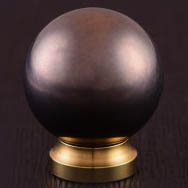 | Titanium is its own element. It is known for being very strong. It can also be anodized electronically to give a wide range of colours. |
| Exotics | |||
| Tungsten | W | 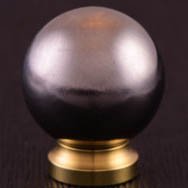 | Tungsten is its own element. It is known for being incredibly dense, and therefore heavy. It can be as much as 9 times heavier then aluminium for the same volume. |
| Tungsten Copper | CuW | 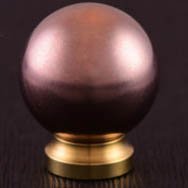 | Tungsten Copper is a mixture (not technically an alloy) of Tungsten and Copper. This means that it retains most of the weight of Tungsten, but has a different colour. |
| Timascus | - | 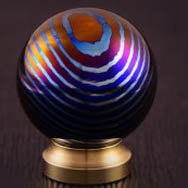 | Timascus is actually a brand name for a metal laminate made by Alpha Knife Supply. It is a layering of different Aluminium alloys which combine to create a wavy pattern. When flamed it can then anodize to blues, purples, and yellows. Different materials such as Zirconium can be “mixed” into the laminate for different looks, such as Black Timascus. |
| Mokuti | - | 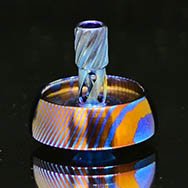 | Mokuti is largely the same material as Timascus, but generally has smaller strips of material creating a finer pattern. Though not always. |
| Damascus Steel | Dammy | 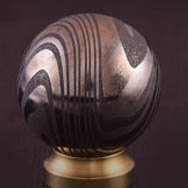 | Damascus steel is an ancient form of steel originating from the city of Damascus in Syria. However, in modern context it is a mixture of steel and iron welded together. This can be done in various patterns to create varying effects. Effects such as Razor wire, Twist, and Spiro. Generally Damascus steel needs to be etched with acid. This will dissolve one of the metals faster than the other, bringing out the pattern more clearly. |
| Damasteel | 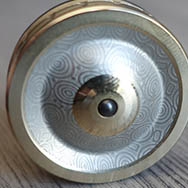 | Damasteel is a Swedish brand name for a type of Damascus steel. They make their own kinds of patterns. | |
| Mokume | - | 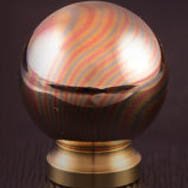 | Mokume is a Japanese metal meaning “wood grain metal” it is a laminate generally of 2-3 materials, such as brass, bronze, copper, or titanium. The varying level of patina leads to a more profound striped pattern. |
| Zirconium | Zirc | 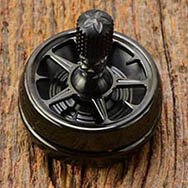 | Zirconium is its own element. Generally is it heat anodized to give a dark black finish. Though in its native state it is silver. |
| Tritium | - | 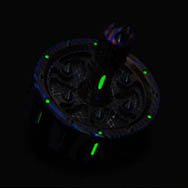 | Tritium is a radioactive isotope of Hydrogen. In spinners and tops it is found in vials. These vials contain the tritium gas and a glow material which is activated by the radiation. This is creates a glow that does not need to be “Charged”. It is illegal to sell tritium in the USA without a license. Though it can be used in giveaways, or purchased from other sellers to be added to a top or spinner. It is totally harmless in the quantities used in a vial. |
| Moonglow | - | 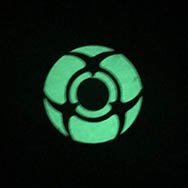 | Moonglow is a type of very efficient and bright glow in the dark plastic. Its properties lend themselves to being easily machined and so can be used by the same machines as the top or spinner makers. |
| Carboquartz | CQ | 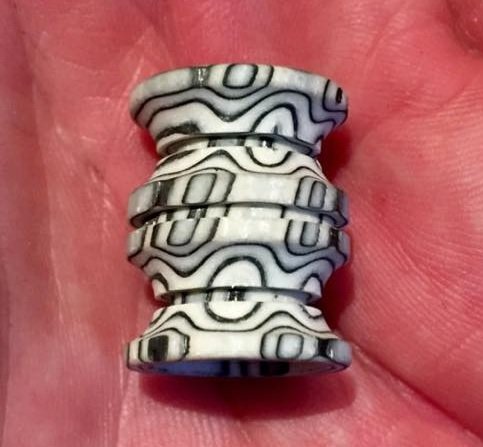 | Carboquartz is a very unique material often found in high end watches such as thouse by Richard Mille. It is a mixture of White Quartx, and TPT carbon. TPT carbon, or Thin Ply Technology carbon is a woven carbon laminate. |
| Super Conductor | SC | 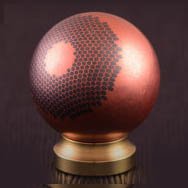 | Super Conductor is a rod made up of smaller Niobium rods, surrounded by copper. This creates a highly conductive material. It is used in spinners and tops purely in an aesthetic manner. As it is not designed for spinning objects, it can be off centre, which can unbalance some spinners/tops. The copper can be etched with acid to make the niobium rods more profound. |
Credit to Billetspin for the pictures of their Spheres range, and tops.
